Scrapy
Posted hpython
tags:
篇首语:本文由小常识网(cha138.com)小编为大家整理,主要介绍了Scrapy相关的知识,希望对你有一定的参考价值。
源码分析
核心组件
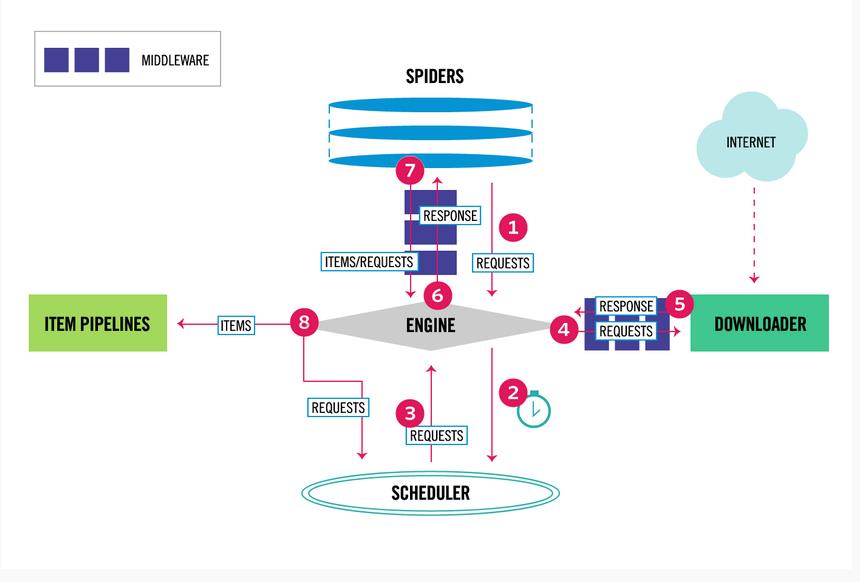
Scrapy有以下几大组件:
Scrapy Engine:核心引擎,负责控制和调度各个组件,保证数据流转;
Scheduler:负责管理任务、过滤任务、输出任务的调度器,存储、去重任务都在此控制;
Downloader:下载器,负责在网络上下载网页数据,输入待下载URL,输出下载结果;
Spiders:用户自己编写的爬虫脚本,可自定义抓取意图;
Item Pipeline:负责输出结构化数据,可自定义输出位置;
除此之外,还有两大中间件组件:
Downloader middlewares:介于引擎和下载器之间,可以在网页在下载前、后进行逻辑处理;
Spider middlewares:介于引擎和爬虫之间,可以在调用爬虫输入下载结果和输出请求/数据时进行逻辑处理;
执行流程:
1、引擎从自定义爬虫中获取初始化请求(url 种子) 2、引擎吧该请求放入调度器,同时引擎调度器获取一个带下载的请求(这辆步异步执行) 3、调度器返回给引擎一个待下载的请求 4、引擎发送请求给下载器,中间经历一系列下载器中间件 5、请求下载完成,生成相应对象,返回给引擎,中间经历一系列下载器中间件 6、引擎受到下载返回的响应对象,然后发送给爬虫,执行自定义逻辑,中间经过一系列爬虫中间件 7、爬虫执行对应的回掉方法,处理这个响应,完成用户逻辑后,生成结果对象或新的请求对象给引擎再次经过一系列爬虫中间件 8、引擎吧爬虫返回的结果对象交由结果处理器,把新的请求对象通过引擎在交给调度器 9、从1开始重复执行,直到调度器中没有新的请求
入口 __main__.py——〉execute(项目、运行环境的设置,解析命令,初始化CrawlerProcess,执行run函数)
http://kaito-kidd.com/2016/11/01/scrapy-code-analyze-architecture/

第一步: scrapy startproject xxxx cd xxxx scrapy genspider chouti chouti.com # 编写代码 scrapy crawl chouti --nolog 第二步:start_requests 第三步:parse函数 - 解析器 - yield item - yield Request() 第四步:携带cookie - 手动 - 自动 第五步:去重规则 第六步:下载中间件
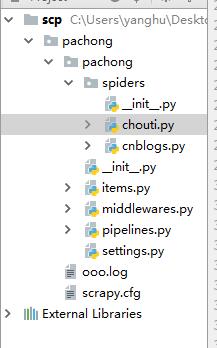

# -*- coding: utf-8 -*- import scrapy from bs4 import BeautifulSoup from scrapy.selector import htmlXPathSelector # HtmlXPathSelector scrapy 自带 from .. items import PachongItem from scrapy.http import Request class ChoutiSpider(scrapy.Spider): name = \'chouti\' allowed_domains = [\'chouti.com\'] start_urls = [\'http://dig.chouti.com/\'] def parse(self, response): """ 当起始url下载完毕后,自动调用该函数,reponse封装了 :param response: :return: """ # print(response.text) # soup = BeautifulSoup(response.text,\'lxml\')# scrap 继承了lxml # div = soup.find(name=\'id\',attrs={"id":\'content-list\'}) # print(div) hxs = HtmlXPathSelector(response=response) # items= hxs.xpath("//div[@id=\'content-list\']/div[@class=\'item\']")[0:4] # with open(\'xxx.log\', \'w\') as f: # 注意 打开文件不能写到for循环中 # for item in items: # href = item.xpath(".//div[@class=\'part1\']/a[1]/@href").extract_first() #extract_first() 提取第一个 # text = item.xpath(".//div[@class=\'part1\']/a[1]/text()").extract_first() #extract_first() # print(text.strip()) # f.write(href) items = hxs.xpath("//div[@id=\'content-list\']/div[@class=\'item\']") for item in items: text = item.xpath(".//div[@class=\'part1\']/a[1]/text()").extract_first() # extract_first() 解析 href = item.xpath(".//div[@class=\'part1\']/a[1]/@href").extract_first() # extract_first() 全部提取 # print(href,text) item = PachongItem(title=text,href=href) yield item #自动返回给已注册pipelines中的函数,去做持久化.必须是个对象,pipelines每次都执行 pages = hxs.xpath("//div[@id=\'page-area\']//a[@class=\'ct_pagepa\']/@href").extract() for page_url in pages: page_url = "https://dig.chouti.com" + page_url yield Request(url=page_url,callback=self.parse)

# -*- coding: utf-8 -*- # Define your item pipelines here # # Don\'t forget to add your pipeline to the ITEM_PIPELINES setting # See: https://doc.scrapy.org/en/latest/topics/item-pipeline.html class PachongPipeline(object): def process_item(self, item, spider): # print(item[\'href\']) self.f.write(item[\'href\']+"\\n") self.f.flush() return item def open_spider(self, spider): """ 爬虫开始执行时,调用 :param spider: :return: """ self.f= open(\'ooo.log\',\'w\') def close_spider(self, spider): """ 爬虫关闭时,被调用 :param spider: :return: """ self.f.close()

# -*- coding: utf-8 -*- # Scrapy settings for pachong project # # For simplicity, this file contains only settings considered important or # commonly used. You can find more settings consulting the documentation: # # https://doc.scrapy.org/en/latest/topics/settings.html # https://doc.scrapy.org/en/latest/topics/downloader-middleware.html # https://doc.scrapy.org/en/latest/topics/spider-middleware.html BOT_NAME = \'pachong\' SPIDER_MODULES = [\'pachong.spiders\'] NEWSPIDER_MODULE = \'pachong.spiders\' # Crawl responsibly by identifying yourself (and your website) on the user-agent #USER_AGENT = \'pachong (+http://www.yourdomain.com)\' # Obey robots.txt rules ROBOTSTXT_OBEY = True # Configure maximum concurrent requests performed by Scrapy (default: 16) #CONCURRENT_REQUESTS = 32 # Configure a delay for requests for the same website (default: 0) # See https://doc.scrapy.org/en/latest/topics/settings.html#download-delay # See also autothrottle settings and docs #DOWNLOAD_DELAY = 3 # The download delay setting will honor only one of: #CONCURRENT_REQUESTS_PER_DOMAIN = 16 #CONCURRENT_REQUESTS_PER_IP = 16 # Disable cookies (enabled by default) #COOKIES_ENABLED = False # Disable Telnet Console (enabled by default) #TELNETCONSOLE_ENABLED = False # Override the default request headers: #DEFAULT_REQUEST_HEADERS = { # \'Accept\': \'text/html,application/xhtml+xml,application/xml;q=0.9,*/*;q=0.8\', # \'Accept-Language\': \'en\', #} # Enable or disable spider middlewares # See https://doc.scrapy.org/en/latest/topics/spider-middleware.html #SPIDER_MIDDLEWARES = { # \'pachong.middlewares.PachongSpiderMiddleware\': 543, #} # Enable or disable downloader middlewares # See https://doc.scrapy.org/en/latest/topics/downloader-middleware.html #DOWNLOADER_MIDDLEWARES = { # \'pachong.middlewares.PachongDownloaderMiddleware\': 543, #} # Enable or disable extensions # See https://doc.scrapy.org/en/latest/topics/extensions.html #EXTENSIONS = { # \'scrapy.extensions.telnet.TelnetConsole\': None, #} # Configure item pipelines # See https://doc.scrapy.org/en/latest/topics/item-pipeline.html ITEM_PIPELINES = { \'pachong.pipelines.PachongPipeline\': 300,#300 优先级 } # Enable and configure the AutoThrottle extension (disabled by default) # See https://doc.scrapy.org/en/latest/topics/autothrottle.html #AUTOTHROTTLE_ENABLED = True # The initial download delay #AUTOTHROTTLE_START_DELAY = 5 # The maximum download delay to be set in case of high latencies #AUTOTHROTTLE_MAX_DELAY = 60 # The average number of requests Scrapy should be sending in parallel to # each remote server #AUTOTHROTTLE_TARGET_CONCURRENCY = 1.0 # Enable showing throttling stats for every response received: #AUTOTHROTTLE_DEBUG = False # Enable and configure HTTP caching (disabled by default) # See https://doc.scrapy.org/en/latest/topics/downloader-middleware.html#httpcache-middleware-settings #HTTPCACHE_ENABLED = True #HTTPCACHE_EXPIRATION_SECS = 0 #HTTPCACHE_DIR = \'httpcache\' #HTTPCACHE_IGNORE_HTTP_CODES = [] #HTTPCACHE_STORAGE = \'scrapy.extensions.httpcache.FilesystemCacheStorage\' DEPTH_LIMIT = 2 #爬取深度两层
http://www.cnblogs.com/wupeiqi/articles/6229292.html
scrapy 代码注释
start_request
start_request中的url 为起始url,是一个生成器,返回一个可迭代对象
spider中初始的request是通过调用 start_requests() 来获取的。 start_requests() 读取 start_urls 中的URL, 并以 parse 为回调函数生成 Request 。

该方法必须返回一个可迭代对象(iterable)。该对象包含了spider用于爬取的第一个Request。 当spider启动爬取并且未制定URL时,该方法被调用。 当指定了URL时,make_requests_from_url() 将被调用来创建Request对象。 该方法仅仅会被Scrapy调用一次,因此您可以将其实现为生成器。 该方法的默认实现是使用 start_urls 的url生成Request。 如果您想要修改最初爬取某个网站的Request对象,您可以重写(override)该方法。 例如,如果您需要在启动时以POST登录某个网站,你可以这么写: def start_requests(self): return [scrapy.FormRequest("http://www.example.com/login", formdata={\'user\': \'john\', \'pass\': \'secret\'}, callback=self.logged_in)] def logged_in(self, response): # here you would extract links to follow and return Requests for # each of them, with another callback pass

# -*- coding: utf-8 -*- import scrapy from bs4 import BeautifulSoup from scrapy.selector import HtmlXPathSelector from scrapy.http import Request from ..items import XianglongItem from scrapy.http import HtmlResponse from scrapy.http.response.html import HtmlResponse """ obj = ChoutiSpider() obj.start_requests() """ class ChoutiSpider(scrapy.Spider): name = \'chouti\' allowed_domains = [\'chouti.com\'] start_urls = [\'https://dig.chouti.com/\',] def start_requests(self): for url in self.start_urls: yield Request( url=url, callback=self.parse, headers={\'User-Agent\':\'Mozilla/5.0 (Windows NT 6.1; Win64; x64) AppleWebKit/537.36 (KHTML, like Gecko) Chrome/63.0.3239.132 Safari/537.36\'} ) def parse(self, response): """ 当起始URL下载完毕后,自动执行parse函数:response封装了响应相关的所有内容。 :param response: :return: """ pages = response.xpath(\'//div[@id="page-area"]//a[@class="ct_pagepa"]/@href\').extract() for page_url in pages: page_url = "https://dig.chouti.com" + page_url yield Request(url=page_url,callback=self.parse,headers={\'User-Agent\':\'Mozilla/5.0 (Windows NT 6.1; Win64; x64) AppleWebKit/537.36 (KHTML, like Gecko) Chrome/63.0.3239.132 Safari/537.36\'})
数据解析
功能:将字符串转换成对象

- 方式一:
response.xpath(\'//div[@id=\'content-list\']/div[@class=\'item\']\')
- 方式二:
hxs = HtmlXPathSelector(response=response)
items = hxs.xpath("//div[@id=\'content-list\']/div[@class=\'item\']")
查找规则:
//a
//div/a
//a[re:test(@id, "i\\d+")]
items = hxs.xpath("//div[@id=\'content-list\']/div[@class=\'item\']")
for item in items:
item.xpath(\'.//div\')
解析:
标签对象:xpath(\'/html/body/ul/li/a/@href\')
列表: xpath(\'/html/body/ul/li/a/@href\').extract()
值: xpath(\'//body/ul/li/a/@href\').extract_first()

from scrapy.selector import Selector, HtmlXPathSelector from scrapy.http import HtmlResponse html = """<!DOCTYPE html> <html> <head lang="en"> <meta charset="UTF-8"> <title></title> </head> <body> <ul> <li class="item-"><a id=\'i1\' href="link.html">first item</a></li> <li class="item-0"><a id=\'i2\' href="llink.html">first item</a></li> <li class="item-1"><a href="llink2.html">second item<span>vv</span></a></li> </ul> <div><a href="llink2.html">second item</a></div> </body> </html> """ response = HtmlResponse(url=\'http://example.com\', body=html,encoding=\'utf-8\') obj = response.xpath(\'//a[@id="i1"]/text()\').extract_first() print(obj)
pipelines
在setting中配置pipeline
ITEM_PIPELINES = { \'pachong.pipelines.PachongPipeline\': 300,#300 值越小 优先级越高 0~1000 \'pachong.pipelines.DBPipeline\': 300,#300 优先级 }
多pipelines ,pipelines返回值会传递给下一个pipelines的process_item
想要丢弃: 使用rasie DropItem
示例

from scrapy.exceptions import DropItem
class FilePipeline(object):
def process_item(self, item, spider):
print(\'写入文件\',item[\'href\'])
# return item
raise DropItem()
pipelines 方法有4种:
1) __init__() 构造方法
2) open_spider()
3) close_spider()
4) from_crawler(), 属于类方法,可以进行类定制
当根据配置文件: ITEM_PIPELINES = { \'xianglong.pipelines.FilePipeline\': 300, \'xianglong.pipelines.DBPipeline\': 301, } 找到相关的类:FilePipeline之后,会优先判断类中是否含有 from_crawler 如果有: obj = FilePipeline.from_crawler() 没有则: obj = FilePipeline() #执行顺序 obj.open_spider(..) ob.process_item(..) obj.close_spider(..)
根据配置文件读取相关值,再进行pipeline处理 ——现在使用了from_crawler方法

from scrapy.exceptions import DropItem class FilePipeline(object): def __init__(self,path): self.path = path self.f = None @classmethod def from_crawler(cls, crawler): """ 初始化时候,用于创建pipeline对象 :param crawler: :return: """ # return cls() path = crawler.settings.get(\'XL_FILE_PATH\') return cls(path) def process_item(self, item, spider): self.f.write(item[\'href\']+\'\\n\') return item def open_spider(self, spider): """ 爬虫开始执行时,调用 :param spider: :return: """ self.f = open(self.path,\'w\') def close_spider(self, spider): """ 爬虫关闭时,被调用 :param spider: :return: """ self.f.close() class DBPipeline(object): def process_item(self, item, spider): print(\'数据库\',item) return item def open_spider(self, spider): """ 爬虫开始执行时,调用 :param spider: :return: """ print(\'打开数据\') def close_spider(self, spider): """ 爬虫关闭时,被调用 :param spider: :return: """ print(\'关闭数据库\')
POST/请求头/Cookie
Post请求头示例

from scrapy.http import Request req = Request( url=\'http://dig.chouti.com/login\', method=\'POST\', body=\'phone=8613121758648&password=woshiniba&oneMonth=1\', headers={\'Content-Type\': \'application/x-www-form-urlencoded; charset=UTF-8\'}, cookies={}, callback=self.parse_check_login, )
第一种
res.headers.getlist(\'Set-Cookie\')获取cookie
第二种:手动获取

cookie_dict = {} cookie_jar = CookieJar() cookie_jar.extract_cookies(response, response.request) for k, v in cookie_jar._cookies.items(): for i, j in v.items(): for m, n in j.items(): cookie_dict[m] = n.value req = Request( url=\'http://dig.chouti.com/login\', method=\'POST\', headers={\'Content-Type\': \'application/x-www-form-urlencoded; charset=UTF-8\'}, body=\'phone=8615131255089&password=pppppppp&oneMonth=1\', cookies=cookie_dict, # 手动携带 callback=self.check_login ) yield req
第三种 自动设置
meta={"cookiejar"=True}
def start_requests(self):
for url in self.start_urls:
yield Request(url=url,callback=self.parse_index,meta={\'cookiejar\':True})
默认允许操作cookie

去重规则
在setting中配置
DUPEFILTER_CLASS = \'scrapy.dupefilter.RFPDupeFilter\' #自定义去重规则 DUPEFILTER_DEBUG = False JOBDIR = "保存范文记录的日志路径,如:/root/" # 最终路径为 /root/requests.seen
和pipelines很像,需要自己编写类,定义去重规则,但是scrapy采用bloomfilter 进行去重

class MyDupeFilter(BaseDupeFilter):
def __init__(self):
self.record = set()
@classmethod
def from_settings(cls, settings):
return cls()
def request_seen(self, request):
if request.url in self.record:
print(\'已经访问过了\', request.url)
return True
self.record.add(request.url)
def open(self): # can return deferred
pass
def close(self, reason): # can return a deferred
pass
为请求创建唯一标识
http://www.oldboyedu.com?id=1&age=2 http://www.oldboyedu.com?age=2&id=1 如上面的两个url只是请求参数变换位置,其实还是指向同一个地址
对url的识别需要使用到request_fingerprint(request)函数
对url排序后hash

from scrapy.http import Request u1 = Request(url=\'http://www.oldboyedu.com?id=1&age=2\') u2 = Request(url=\'http://www.oldboyedu.com?age=2&id=1\') result1 = request_fingerprint(u1) result2 = request_fingerprint(u2) print(result1,result2)
问题:记录到低要不要放在数据库?
【使用redis集合存储】 访问记录可以放在redis中。
dont_filter
from scrapy.core.scheduler import Scheduler
def enqueue_request(self, request):
# request.dont_filter=False
# self.df.request_seen(request):
# - True,已经访问
# - False,未访问
# request.dont_filter=True,全部加入到调度器
if not request.dont_filter and self.df.request_seen(request):
self.df.log(request, self.spider)
return False
# 如果往下走,把请求加入调度器
dqok = self._dqpush(request)
中间件
请求头USER_AGENT设置
问题:对爬虫中所有请求发送时,携带请求头?
方案一:在每个Request对象中添加一个请求头
方案二:下载中间件
setting中配置:
DOWNLOADER_MIDDLEWARES = {\'xianglong.middlewares.UserAgentDownloaderMiddleware\': 543,}
编写类:

class UserAgentDownloaderMiddleware(object):
@classmethod
def from_crawler(cls, crawler):
# This method is used by Scrapy to create your spiders.
s = cls()
return s
def process_request(self, request, spider):
# Called for each request that goes through the downloader
# middleware.
# Must either:
# - return None: continue processing this request
# - or return a Response object
# - or return a Request object
# - or raise IgnoreRequest: process_exception() methods of
# installed downloader middleware will be called
request.headers[\'User-Agent\'] = "Mozilla/5.0 (Windows NT 6.1; Win64; x64) AppleWebKit/537.36 (KHTML, like Gecko) Chrome/63.0.3239.132 Safari/537.36"
# return None # 继续执行后续的中间件的process_request
# from scrapy.http import Request
# return Request(url=\'www.baidu.com\') # 重新放入调度器中,当前请求不再继续处理
# from scrapy.http import HtmlResponse # 执行从最后一个开始执行所有的process_response
# return HtmlResponse(url=\'www.baidu.com\',body=b\'asdfuowjelrjaspdoifualskdjf;lajsdf\')
def process_response(self, request, response, spider):
# Called with the response returned from the downloader.
# Must either;
# - return a Response object
# - return a Request object
# - or raise IgnoreRequest
return response
def process_exception(self, request, exception, spider):
# Called when a download handler or a process_request()
# (from other downloader middleware) raises an exception.
# Must either:
# - return None: continue processing this exception
# - return a Response object: stops process_exception() chain
# - return a Request object: stops process_exception() chain
pass
如return none 继续执行下一个中间件,returen Request(...)返回调度器产生死循环
四种返回结果如下图
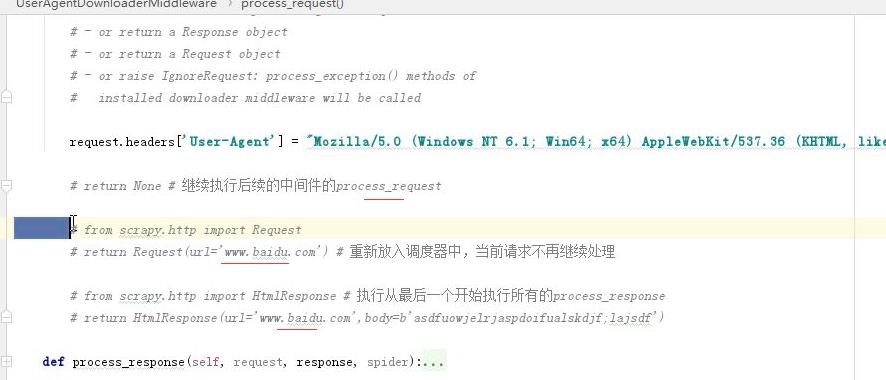
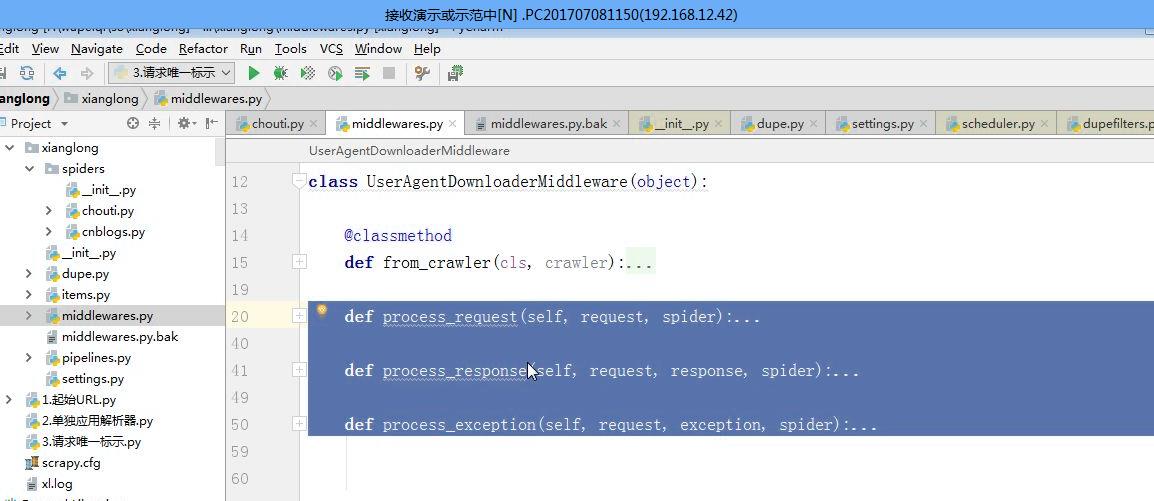
下载中间件: scrapy中如何添加代理
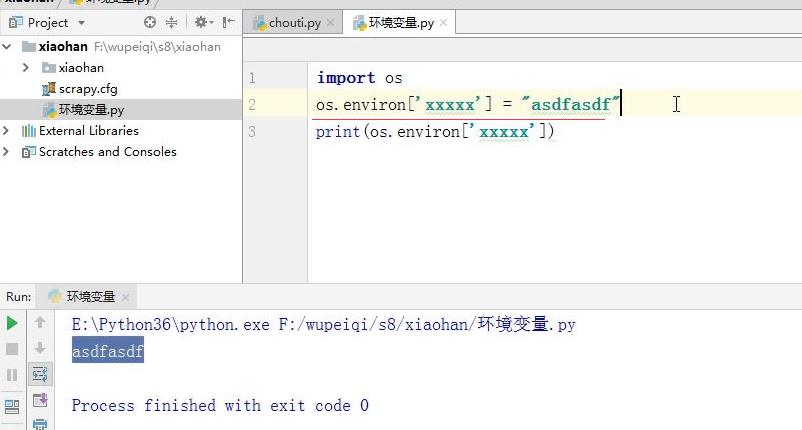
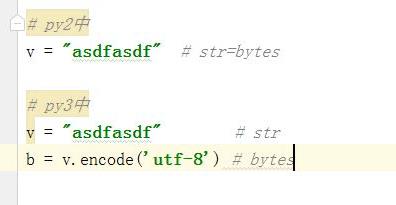
加代理,只是在请求头中设置信息
方式一:
内置加ip
os.envriron[\'HTTP_PROXY\']=\'http://192.168.0.0.1\'
方式二:自定义下载中间件

import random import base64 import six def to_bytes(text, encoding=None, errors=\'strict\'): """Return the binary representation of `text`. If `text` is already a bytes object, return it as-is.""" if isinstance(text, bytes): return text if not isinstance(text, six.string_types): raise TypeError(\'to_bytes must receive a unicode, str or bytes \' \'object, got %s\' % type(text).__name__) if encoding is None: encoding = \'utf-8\' return text.encode(encoding, errors) class MyProxyDownloaderMiddleware(object): def process_request(self, request, spider): proxy_list = [ {\'ip_port\': \'111.11.228.75:80\', \'user_pass

